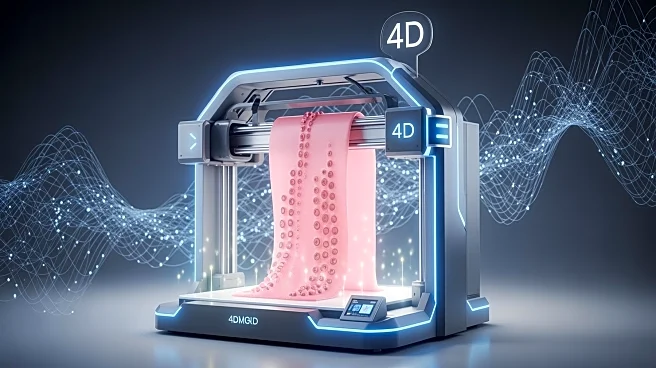What's Happening?
A recent study has introduced a novel 4D printing technique that creates stimulus-reconfigurable binary domains in hydrogel films, inspired by cephalopod skin. The research utilizes halftone-encoded patterns to control the optical appearance and mechanical
properties of the films. By varying UV exposure times during printing, the degree of crosslinking in the hydrogels is manipulated, resulting in distinct variations in optical transmittance and mechanical properties. This method allows for dynamic information encryption and decryption, mimicking the communication and camouflage capabilities of cephalopods. The study highlights the potential for these smart skins to transform from 2D to 3D shapes, offering applications in dynamic information concealment and revelation.
Why It's Important?
The development of cephalopod-inspired smart skins through 4D printing represents a significant advancement in material science, with potential applications in various fields such as security, robotics, and wearable technology. These smart skins can dynamically change their optical and mechanical properties, providing new ways to encrypt and decrypt information. The ability to mimic cephalopod skin's adaptive capabilities could lead to innovations in camouflage technology and responsive materials. Industries focused on security and privacy stand to benefit from these developments, as the technology offers enhanced methods for information concealment and revelation.
What's Next?
Future research may explore the integration of these smart skins into commercial products, such as adaptive clothing or responsive surfaces in architecture. The study opens avenues for further exploration into the scalability and practical applications of these materials. Stakeholders in the tech and security industries might invest in developing prototypes that utilize this technology for real-world applications. Additionally, collaborations between material scientists and engineers could lead to the creation of new devices that leverage the dynamic properties of these smart skins.
Beyond the Headlines
The ethical implications of using smart skins for information encryption and camouflage are significant. As these materials become more advanced, questions about privacy and surveillance may arise. The ability to conceal information dynamically could lead to debates about the balance between security and transparency. Furthermore, the cultural impact of materials that mimic natural organisms like cephalopods could influence design and aesthetics in various industries, promoting a shift towards biomimicry in technology.















